The dramatic landscapes of Scotland are home to some of Britain’s most spectacular gardens. From blazing rhododendrons in the north west to the unlikely spectacle of bananas and palm trees overlooking the Firth of Clyde, gardens in this wild and wonderful country are unique and unexpected.
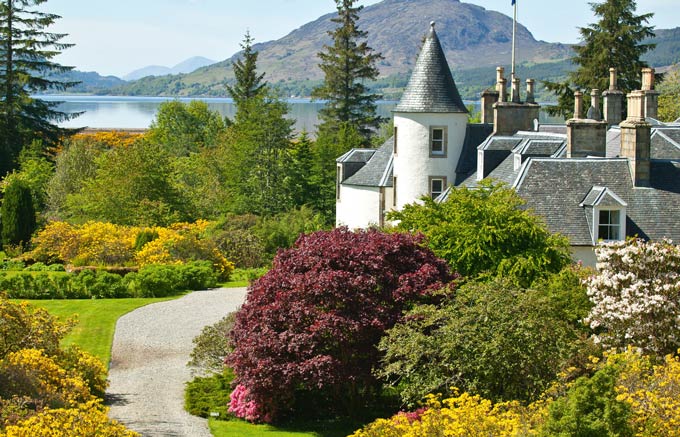
When you think of Scotland you might imagine high mountains, deep lochs and moorland covered in heather. Scotland has all of these in abundance, but despite the ruggedness of the countryside, the northern tip of Britain is a paradise for plant lovers and is home to gardens of all types.
Cool summers, clean air and high rainfall levels offer the perfect conditions for growing an astonishing range of species from many different corners of the world and this has been harnessed to create a large number of outstanding gardens. The West Coast is famous for its great rhododendron gardens that in spring explode with colour, while in the east of the country there are many finely designed landscapes such as those surrounding the great castles that are strung out along Royal Deeside like precious pearls.
This is gardening on a grand scale, set against a landscape of epic proportions, and generations of visionaries have set themselves the challenge of creating gardens here that are as spellbinding as the scenery that surrounds them.
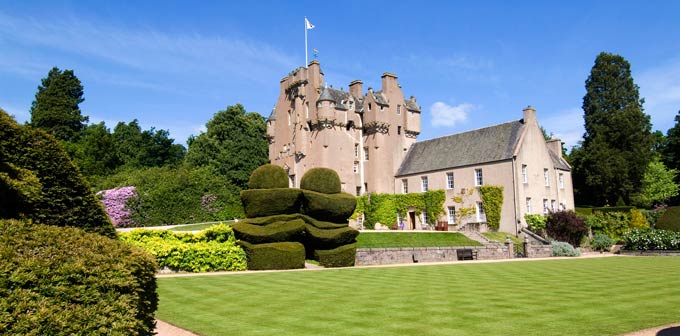
HIGHLANDS
The north west of Scotland is one of the wettest parts of the country and at Attadale in Wester Ross, Nicky MacPherson has harnessed the elements to create a beautiful water garden, with falls that come tumbling off the cliffs and dark, shining lily ponds created by enlarging an old mill-stream. Bridges crisscross the still water and bog-loving plants smother the margins, while around the garden are many fine sculptures, some of them created by Nicky herself.
Today this is a garden filled with surprises, amongst them the giant sundial set within a semicircle of rhododendrons, roses and hydrangeas and the geodesic dome where head gardener Geoff Stephenson houses part of an astonishing collection of ferns. And there is a Japanese garden too, designed as a place of peace and quiet contemplation. Climb to the viewpoint and enjoy the view over Attadale House to Loch Carron and Skye in the distance.
From the fairytale turrets of Crathes Castle on Royal Deeside, visitors can look out across one of Scotland’s most celebrated gardens. In summer the double herbaceous borders are a haze of bright colours and in the greenhouses rare Malmaison carnations perfume the air with their sumptuous scent.
This is gardening at its most high-maintenance, from the crisp edges of the yew hedging to the eight garden rooms where strict colour-theming is in force. One of the best is the immaculate white border, which predates the famous White Garden at Sissinghurst. Beyond the walled garden lie woodlands and an arboretum, which is home to rare red squirrels and otters.
It was on a small hillock in the grounds of Brodie Castle that Macbeth allegedly encountered his three witches. Today visitors to this 16th-century castle near Forres are drawn not for the doomsayers but for the daffodils, which throughout April grow in vast sheets right across the grounds. It was the 24th Brodie of Brodie who bred daffodils here and of the 400 varieties that grow around the castle today, 100 of Major Ian Ashley Brodie’s originals remain.
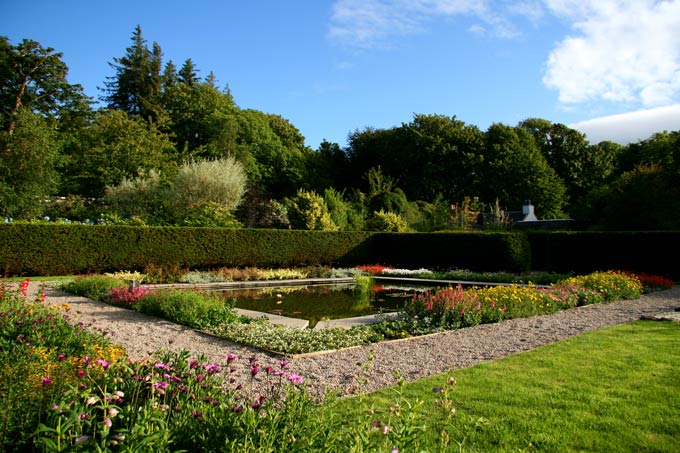
ISLANDS
The waters around Scotland contain almost 800 islands, each with its own defining character. They include Iona, the ancient burial place of kings, and the Orkneys, which are strewn with Neolithic monuments and relics of their Viking past. But of all Scotland’s islands, none is as shrouded in mist and romance as Skye. Whitewashed crofts sit under the shadow of the magnificent Cuillin mountain range, while close to the northern tip of the island is Dunvegan Castle which for more than 800 years has been the stronghold of the Chiefs of the Clan MacLeod.
The castle itself perches on a rocky precipice above Loch Dunvegan while the gardens are situated on the hillside behind it. There’s a walled garden where roses and old fruit trees are sheltered from the Atlantic gales and, in the woodlands, waterfalls tumble through a series of pools surrounded by rhododendrons, hydrangeas and azaleas. Visit in summer to see Crinodendron, Embrothium and other Chilean species flourishing in the mild environment and don’t leave without catching a glimpse of the Fairy Flag, which was reputedly given to an infant chief by the ‘Wee Folk’ as protection for the clan.
Far to the south of Skye, the island of Colonsay bobs on the Atlantic swell like a ship at anchor. Just eight miles long and two miles wide, it has world-class beaches and breathtaking views over the Inner Hebrides. Colonsay House was built in 1722 but it was in the 1930s that the third Lord Strathcona began a programme of landscaping and planting that saw the gardens develop one of the finest collections of rhododendrons in private hands. Next to a well is a carved stone, dedicated to St Oran, which is believed to date from the 7th or 8th century and the lens from the Rhubhal lighthouse on Islay makes a striking centrepiece to the garden. From May until July the machair on Colonsay is in flower. This grassy pasture is unique to the Hebrides and Ireland and it is studded with flowers, including wild orchids.
The island of Bute on the Firth of Clyde boasts an astonishing example of Victorian Gothic Revivalism. Everything about Mount Stuart is on a grand scale; including its gardens, which feature woodland walks, stretches of shoreline, a Victorian Pinetum and a Rock Garden created by Thomas H Mawson, one of the 19th century’s most celebrated architects. Since then leading garden designers have played a part in creating the striking plantings around the contemporary visitor centre and in redeveloping the huge kitchen garden.
At Lea Gardens on Shetland, owner Rosa Steppanova has designed every feature herself, including the many sculptures made from driftwood, fishing nets and other flotsam washed up on the shoreline, which lies just 200m away. This is gardening on the edge and for 30 years Rosa has been rewriting the rulebook on what will survive at the northern-most limit of Scotland.
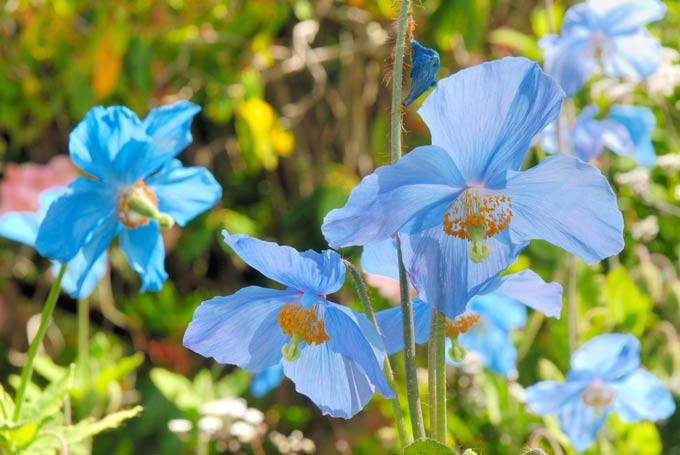
HEADLANDS
It is hard to believe that Scottish laird Osgood Mackenzie looked out over the barren, rocky peninsula of Am Ploc Ard in remote Wester Ross and decided that it was the perfect place for a garden. It took a lifetime of endeavour, during which soil was imported, a vast shelterbelt was planted and an extraordinary curving walled garden was created on a raised beach, for that vision to become a reality at Inverewe. But today sub-tropical species flourish on the 58th parallel, the same latitude as Hudson’s Bay and St Petersburg.
The woodland is home to 2,500 species of trees and shrubs from around the world and water lilies cover a series of serene ponds. In recent years the garden has enhanced its South African collection and now Kniphofias, Watsonias and Osteospermums flourish.
If you were to throw a stone from the tower of the Castle of Mey it would land in the Pentland Firth, that wild stretch of water that separates Scotland from Orkney. The castle is the most northerly garden on the mainland and it was just a ruin when the late Queen Mother sighted it from the Royal Yacht Britannia and set about restoring it.
The Shell Garden, with its climbing roses, pansies and nasturtiums would become her favourite spot and today visitors can buy produce from the vegetable garden and enjoy the smells, textures, tastes and colours of the beautiful Sensory Border. Meanwhile the Diamond Jubilee Rose Garden, which was planted to mark the tenth anniversary of her death, is now beginning to flourish.
Culzean Castle in Ayrshire sits astride a sheer cliff overlooking the Firth of Clyde. Behind this magnificent Robert Adam mansion lie 565 acres of landscaped parkland including a sunken garden, a fountain garden with bananas and palm trees, a camellia house filled with tender treasures and a huge walled garden flanked by a restored Victorian greenhouse where grapes hang from productive vines. The first Marquess of Ailsa oversaw the planting of five million trees and today the woodlands remain one of Culzean’s many glories.
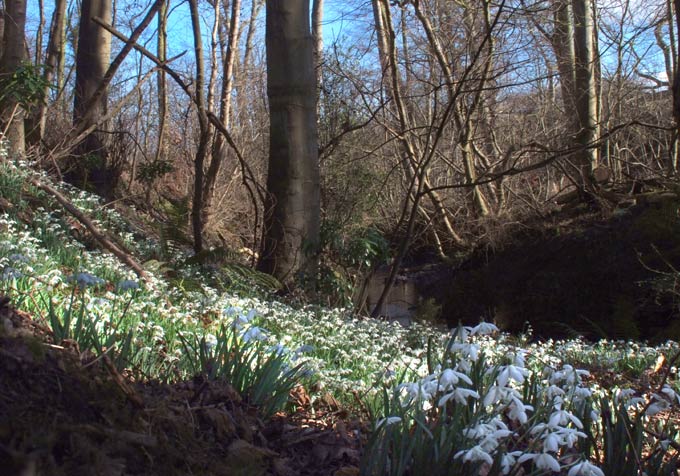
WOODLANDS
Carved out of beech woods in a valley to the south of the Tweed lies one of Scotland’s best woodland gardens. For more than 300 years successive owners have planted trees on Dawyck’s slopes, at times financing plant hunters to secure them the newest introductions that during the 18th and 19th centuries were emerging from China and North America.
Over the centuries Dawyck, which is now an outpost of the Royal Botanic Garden Edinburgh, has grown into an extraordinary arboretum containing some of the country’s oldest and most beautiful trees.
In spring the Azalea Terrace is awash with scent and in autumn the Beech Walk gives views over the canopy as it takes on its magnificent colours. And at all times the Scrape Burn, a cool mountain stream, burbles over falls and under bridges on its way to the Tweed.
In early spring the woodland floor at Cambo House near St Andrews is an almost seamless blanket of white as snowdrops emerge from beneath the litter of last autumn’s leaves to scent the air with their delicate perfume.
The Erskine family has for generations planted snowdrops at Cambo but it is the current Lady Erskine who has cemented the estate’s reputation as an unmissable destination for ‘galanthophiles’. In February the Snowdrops by Starlight Festival works a magical transformation on the woodlands, illuminating the trees and streams that surround the 70 acres of snowdrops. And if you thought every snowdrop was identical, the National Collection of 300 different varieties will open your eyes to the startling diversity of the natural world.
Scotland provides the ideal habitat for many plants from across the globe, so perhaps it should come as no surprise that this small country has produced the greatest concentration of plant hunters in the world.
At The Explorers Garden the feats of men like Robert Fortune, Archibald Menzies and Francis Masson, whose names are immortalised in some of our favourite plants, are celebrated in a woodland setting above the Pitlochry Festival Theatre. The garden is packed with many rare and beautiful plants but its most outstanding feature is the pavilion made from many different kinds of wood, with a roof that represents a folded leaf and balcony like the bow of a ship; it was designed as a tribute to David Douglas whose contribution to botany continues to influence our gardens and landscapes.

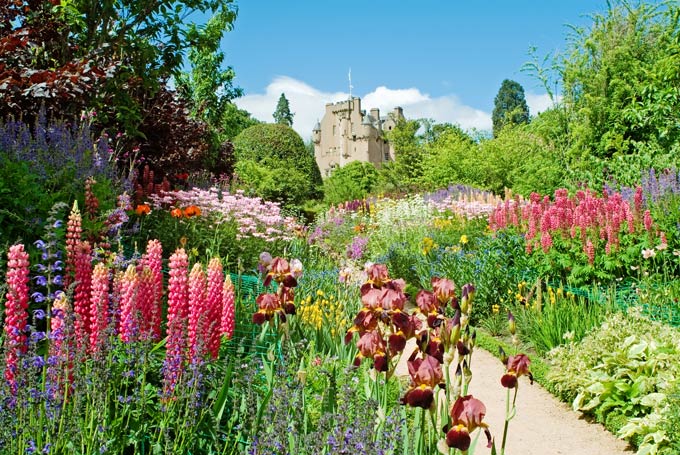




 © 2024
© 2024